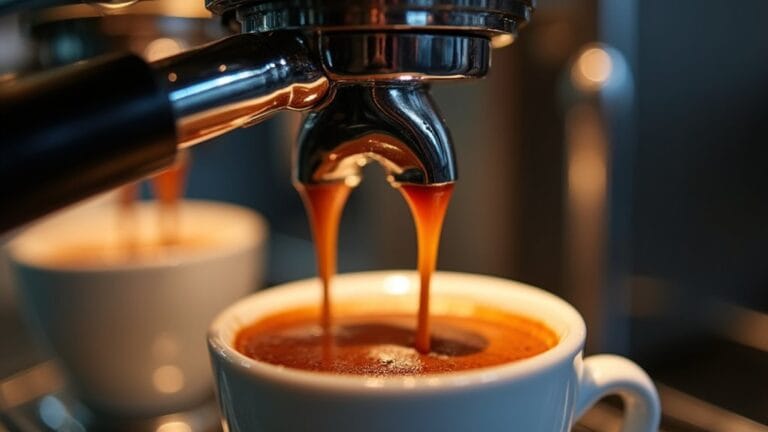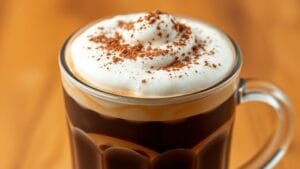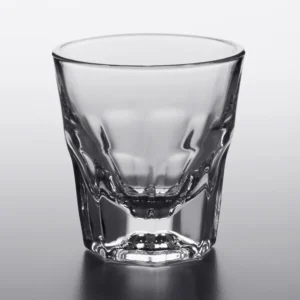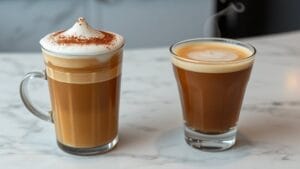What Is Espresso Coffee
Espresso isn’t just super-strong coffee, it’s a tiny, syrupy shot made by blasting hot water through tightly packed, super-fine grounds!
Born in Italy, the name means “pressed out,” which actually tells you what happens when that water zoom-pushes through the coffee, and the whole thing began as a speedy perk-up for busy folks way back in the day.
The real kicker is that espresso tastes bold and layered because of that pressure magic, not just because the beans are extra dark, so saying it’s just “strong coffee” is like calling a rocket a fast toy car, which is, well, hilarious!
The Real Definition of Espresso
The tiny cup holds a rocket-fuel coffee that’s basically magic! Cafe espresso coffee is made by blasting 90-96 °C water at 6-9 bar through super-fine grounds for 25-30 moments. This espresso coffee kicks out a 25-30 ml shot with thick crema foam, loads more solids than drip, bold bitter-sweet-tart flavor, and velvety body. It retains Italian heritage from Angelo Moriondo’s 1884 patent in Turin and Luigi Bezzera’s 1901 improvements that unlocked daily one-cup service. Espresso is characterized by its rich flavors that are a result of precise extraction parameters and quality beans.
A double shot just doubles the fun. Even though it tastes supercharged, one sip carries less caffeine than a full mug of regular brew!
Origins and Meaning Behind the Name
Back when steam engines still sounded cool, a guy named Luigi Bezzera was fed up with slow coffee and built a steam-blasting metal box that squashed hot water through coffee dust.
In 1903, this wild Italian contraption brewed in 45 moments—lightning fast for those days!
The name “espresso” popped from the Italian words esprimere (to press out) and express (super-fast trains)—both fitting because steam pressure squeezed the drink while lightning speed served it.
Desiderio Pavoni later pushed the gadget, making “caffè espresso” shorthand for “fast-pressed coffee for you.”
That catchy combo of quick, small, and pressed stuck for good, turning espresso into the tiny, bold shot we slurp at the counter now—no fancy jargon needed!
Why Espresso Isn’t Just Strong Coffee
Three things set espresso apart like a tiny superhero in the coffee world. Pressure, grind, and crema make it magic.
A 9-bar pressure shove blasts 200°F water through sugar-fine grounds in 25 moments. Drip coffee waits six minutes for gravity to yawn and drip.
The espresso puck births crema, a shiny, nut-brown foam blanket drip coffee can’t grow. Dark roast beans bring chocolate fireworks, and the liquid ends up syrupy-thick.
A one-ounce shot tastes like a brownie hug, not just “strong coffee.” Bonus twist: despite its punchy flavor, a full mug of drip often sneaks in more total caffeine, so espresso flexes flavor muscles, not just caffeine biceps.
How Espresso Is Made
To pull real espresso, you lock super-fine coffee into a metal handle, then blast near-boiling water through it at nine bars of steady pressure.
Within twenty-five to thirty tight moments, the machine turns those gritty grounds into a bright 36-gram stream topped with thick crema—it’s like watching liquid lightning in slow motion.
The 9-Bar Pressure Brewing Method
Science calls it greatness, this espresso magic that starts with one number: nine.
Nine bars push water through tight grounds, like thirty elephants stomping on an ice cube tray. Initially, soft taps called pre-infusion wake the coffee up in three short seconds—think blowing gently on cocoa so it doesn’t go everywhere. Each shot typically contains 63-77 mg of caffeine from the espresso used.
Then, full nine-bar blast kicks in for 25 seconds, ripping oils, sugars and acids into tiny brown rainbows while building fluffy crema on top. Baristas call this flavor gold—bitter, sweet, tangy, all at once. This process relies on the high-pressure extraction method that enhances flavor balance in every shot.
After that, pressure drops to a chill five so the shot doesn’t taste like burnt toast. Voilà, espresso done right—tiny sips packed with giant punch!
Fine Grind Requirements
Before the nine bars even flex their muscle, the coffee has to shrink—way down to gritty specks almost as tiny as beach sand that sneak between fingers, because only a super-fine grind can slam on the brakes and force high-pressure water to slow-dance with the grounds, sucking out every sweet, tangy, smoky drop while dodging the evil twins of sour under-shots and bitter over-shots; think of it like packing Play-Doh in a straw—too chunky and the water zips through like a racecar, too powdery and it clogs like hair in a sink, but hit the sweet spot—salt-like specks that still crunch—and the espresso pours in 25-ish ticks, thick like melted chocolate and crowned with a golden crema that smells like warm cookies and happy mornings. The precision in grind size is crucial to achieving the balanced extraction that espresso coffee is famous for.
25-30 Second Extraction Process
Right beneath the group head, a long hiss turns into a sip of liquid gold when the pump kicks in, around 25 to 30 instances, is the magic countdown everybody talks about! The timer starts as water kisses the puck, pushing roughly one ounce for a single or two ounces for a double, all while crema forms like tiny caramel clouds.
Too fast means sour water; too slow tastes bitter tar. Baristas tweak grind finer or coarser until that brown mouse-tail flows steady. A scale sits under the cup, checking every drop.
If espresso drips after seven instances, something’s funky—grind finer, tamp harder, or maybe the beans scream for mercy. Espresso’s concentrated nature results in a rapid feeling of energy compared to other brewing methods.
What Makes Espresso Unique
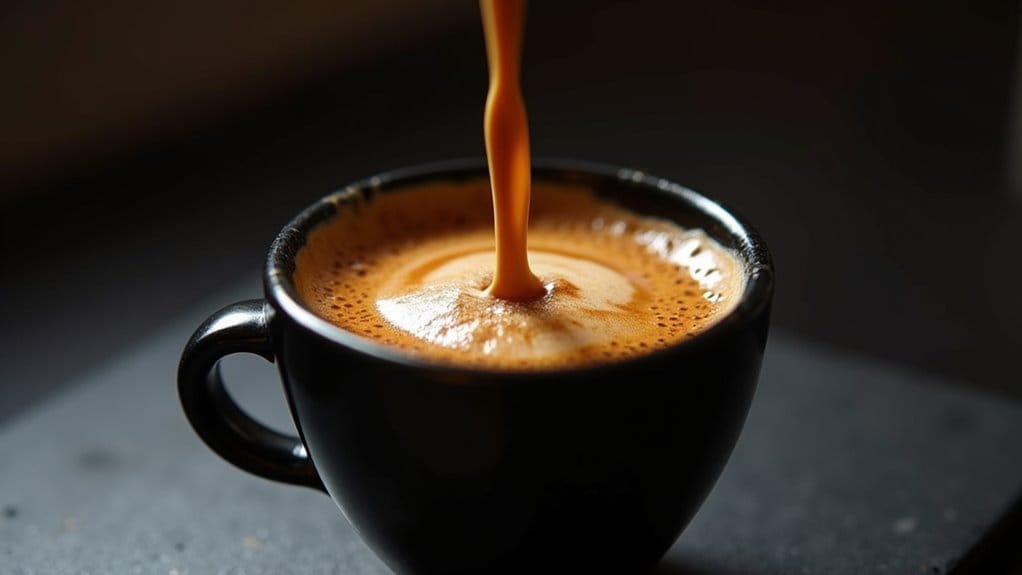
Picture a tiny cup holding liquid magic that tastes like coffee turned up to eleven—that’s espresso, and no other drink dares to match it! Espresso shoots 9 bars of hot water through superfine grounds, and in just 25 ticks it locks in chocolate, caramel, nuts, and bright citrus notes, all topped with golden crema made of silky bubbles and oils that pop flavor fireworks in your mouth. The pour over method provides a contrasting brewing experience that extracts maximum flavor richness from coffee beans. One shot packs 63 mg of caffeine, yet fits in a cute demitasse cup, ready to morph into cappuccinos, lattes, or straight rocket fuel. Additionally, espresso serves as the core ingredient in every mocha, enriching the flavor profile of this beloved coffee beverage.
- Pressure power
- Flavor burst
- Tiny mighty
Espresso vs Regular Coffee
Espresso and regular coffee are basically cousins who grew up in the same bean family but then went to totally different schools, and wow, do they act different!
| Factor | Espresso | Regular Coffee |
|---|---|---|
| Roasts | Dark, oily, bold | Light to dark range |
| Grind | Super fine powder | Medium to coarse |
| Brew style | 9 bar pressure, 25 moments | Gravity drip, 4-12 minutes |
| Texture | Thick, syrupy, crema on top | Light, tea-like body |
| Flavor punch | Concentrated 10-13% solids burst | Gentle 1-2% extraction |
Think lightning-fast espresso dragon versus slow-drip mellow turtle. Additionally, while espresso typically uses medium to dark roast for optimal flavor, blonde roast coffee can have more caffeine per ounce compared to dark roast coffee. Coffee’s caffeine levels can also vary widely, influencing the flavor profile and energy boost it provides.
Caffeine Content Facts
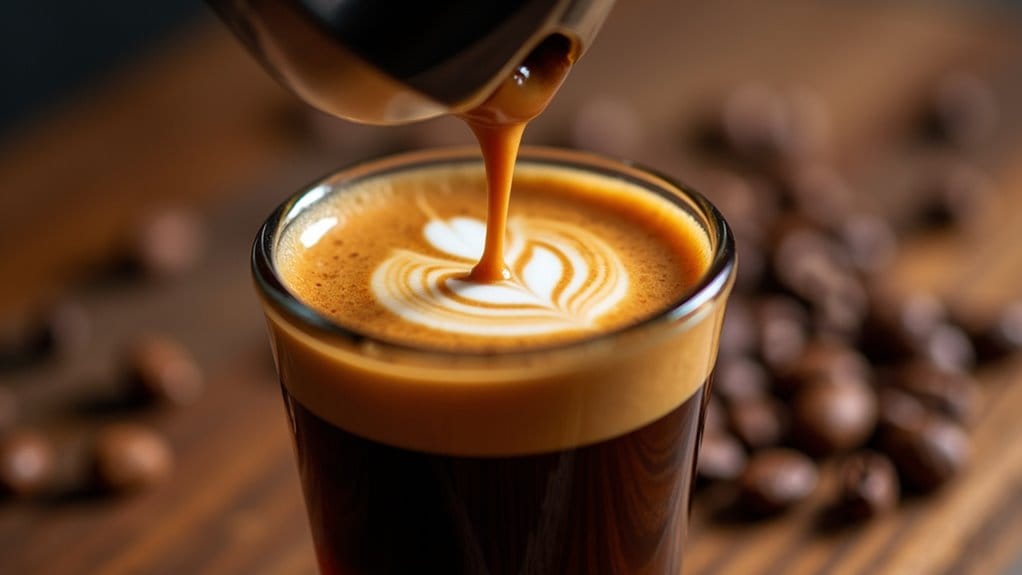
A single tiny espresso shot sneaks in way more caffeine per teaspoon than any other coffee trick, packing roughly 57 to 75 milligrams of the buzzy stuff into just one little ounce—picture a melted LEGO® brick–sized sip that feels like your brain just hopped on a rollercoaster!
Compared drip coffee is weak sauce: espresso delivers 4,200 mg per liter, doubling cold brew’s 2,240 mg and stomping drip’s measly 692 mg.
Size matters though—espresso’s portion is smaller, so total caffeine might clock less than big 12-ounce mugs. A barista’s moment or subsequent shot can spike the punch to 140 mg, while a cappuccino with steamed milk lands near 100 mg!
When to Choose Espresso Coffee
Why would someone ditch a giant mug for a tiny shot? When the brain needs rocket fuel, the body craves zip, or the belly wants a hug, espresso wins!
Ditch the gallon, grab the grenade: espresso’s a lightning bolt in a thimble.
It’s lightning-caffeine for homework sprints, gym lifts, and post-pizza burps that beg for soothing.
- Brain Blast: One gulp equals a laser focus pill.
- Workout Zip: Pre-run shot turns legs into turbo hamsters!
- Tummy Hug: After food, small sip calms the grumbles and burns off bloat. Coffee culture not only elevates espresso drinking but also emphasizes its role in global social hubs.
Frequently Asked Questions
Can Espresso Shots Go Stale Instantly?
Instant staling of espresso shots observable; volatile oils oxidize immediately, crema collapses within minutes. Sensory degradation begins moments after extraction, yielding bitter, stale flavor. Immediate consumption essential for ideal taste retention.
Why Do Some Coffee Beans Foam More?
Data reveal beans retain up to 98 mL CO₂ per gram after roasting. Variability stems from darker roasts releasing 30 % more gas during brewing than light ones, generating pronounced foam.
Is Crema Volume Tied to Freshness?
Is crema volume tied to freshness? Yes, within limits: fresher beans provide more CO₂, generating fuller crema during extraction.
Does Water Hardness Affect Crema Texture?
The question asserts water hardness alters crema texture. High mineral concentrations diminish foam stability through calcium-protein interactions, soft water thins body, and calcium around 51–85 ppm yields balanced microstructure.
Should You Swirl Espresso Before Sipping?
Can the liquid itself speak without gentle persuasion? The observer advises controlled swirling; it integrates crema gradually, keeps bitter foam partial, preserves layered mouthfeel, and releases aromatic complexity each measured sip reveals.
References
- https://en.wikipedia.org/wiki/Espresso
- https://flairespresso.com/learn/espresso-guide/espresso-101/
- https://sagebrushcoffee.com/blogs/education/why-espresso-beans-are-not-a-thing
- https://espressocoffeeguide.com/all-about-espresso/
- https://counterculturecoffee.com/blogs/counter-culture-coffee/guide-to-espresso
- https://www.fnp.com/article/how-did-espresso-get-its-name
- https://esquirescoffee.co.uk/news/history-espresso/
- https://crowdroaster.com/story/104
- https://www.greenfarmcoffee.co.uk/origins-of-coffee-drinks/

